by Ajay Talwar
- Published: Wednesday, April 03 2013 07:00
My first experience of an observatory was quite a memorable and pleasant one. A few budding amateur astronomers arrived at the Nainital Observatory in the Himalayan foothills, quite unannounced on a very wintery morning. Having travelled overnight from New Delhi we were tremendously excited at the prospect of looking at a large – One Metre telescope at the Uttar Pradesh State Observatory. Despite being unannounced, we were made quite welcome. We were given a tour of the entire facility, shown all large and small telescopes in every nook and corner, including the old Baker-Nunn satellite camera. Alas it was a cold and cloudy January night and the sky had packed up completely, so we could not observe with any telescope that night.
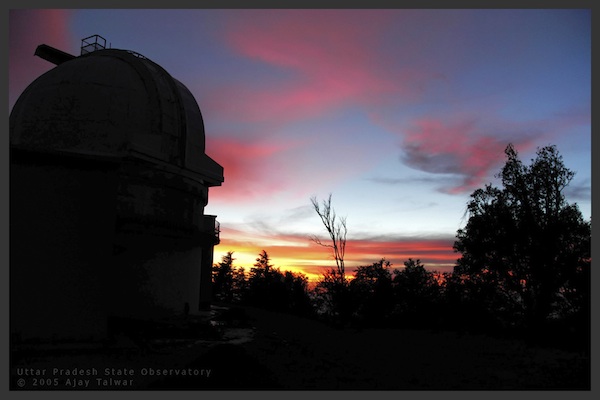
The Uttar Pradesh State Observatory at Nainital. It is now known as ARIES.
Between my first visit in 1987 and now I have visited the Nainital Observatory several times every year. I have spent some exceptionally good time at the observatory. A few significant instances come to mind – a visually productive night with the Cooke 10 inch f/15 refractor with a gravity assisted clock drive. Another time we stayed at the observatory for 15 days, working in the optics lab, finishing our 16 inch mirror which we were building for ourselves. I remember many instances of night observations from the side terrace of the one metre telescope. Nights spent with other amateur astronomers and sometimes all alone, with no one around for the entire night. The first national star party of India – Milky Way Voyage was organised at the Nainital observatory, around 250 amateur astronomers from all over the country were present, and the facilities graciously provided by the Nainital Observatory.
Nainital observatory is 9 km from the famous hill station of Nainital, by road, but if you walk a trail, the distance is just 4 km. The observatory atop Manora Peak is close to the hill town. The town is growing and shedding its light, actually light pollution, on the observatory.
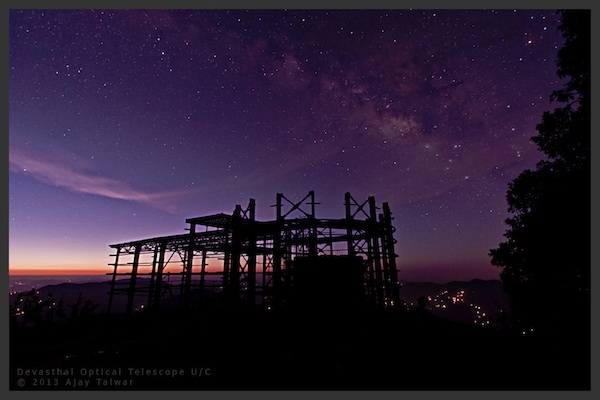
Devasthal Optical Telescope, under construction 3.6m segmented mirror telescope, the largest in India
Now ARIES is setting up a 3.6 metre segment mirror telescope. The site is east of Nainital and is called Devasthal. Standing on the highest point, peak of Devasthal, you can see in all directions, till the horizon. To the city dwellers, it seems as if you can see below the horizon, but that is only an illusion. Here at the peak it takes a while to judge the directions towards different places. You can see towards the plains, the town of Kathgodam and the foggy lights of Sidcul industrial area, Rudrapur, 50 km distant, heading - 212°. You can see towards the north, snow-capped Himalayas. In clear weather you can see the white peaks of Nanda Devi, Trishul, Panchachuli and many more. The Nanda Devi is 115 km distant, heading 15°. In the west, heading 269° and 22 km distant you have an interesting peak, The Manora Peak and ARIES. The geographical latitudes of Devasthal Peak and Manora Peak are identical down to the minutes. Devasthal Peak being 29° 21' 41" and Manora Peak being 29° 21' 31". Quite a coincidence. So as seen from Devasthal the star Mintaka, of the Belt of Orion, would set over ARIES.
The peak of Manora lies at an altitude of 1951 metres while Devasthal is approximately 500 metres higher. In the daytime you can see the white one metre dome atop Manora, but in the evenings and night the observatory is lost in the haze. When the largest telescope in India, the 3.6 metre telescope is complete at Devasthal though, its dome would be quite visible from Manora Peak and would lie among the rising stars and not below the misty horizon.
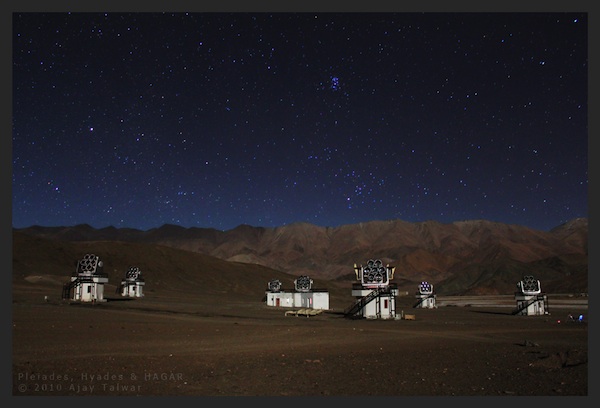
High Altitude Gamma Ray Telescope Array (HAGAR) Installed at Hanle, Ladakh
The Indian Astronomical Observatory at Hanle, Ladakh is really a good place to do astronomy. The place is bone dry, earth as well as the atmosphere. My first visit to IAO at Hanle, Ladakh was in June 2007. Four amateurs from AAA – Delhi had travelled by car. The observatory is about 260 km from Leh and the route goes upstream the Indus River, towards south-east. After getting stuck in sand and losing our way (as there was no road built then), we reached the (then) Highest Observatory in the World, at 2 am. As we got out of the car, we were astounded looking at the zenith. Milky Way was white and bright as we had never seen before. Next day afternoon we could spot Venus at Noon! Just like that! At Hanle, we were euphoric and above half the atmosphere. A remote location high in the Ladakh hills which has low humidity, low atmosphere (oxygen), low temperatures, high radiation. IAO Hanle is certainly a good place for doing astronomy, but at the same time bad for a human body, stay out in the sun for 10 minutes and your face is burnt. No wonder it is controlled from Bangalore via satellite. Hanle also has the High Altitude Gamma Ray Telescope Array – HAGAR.
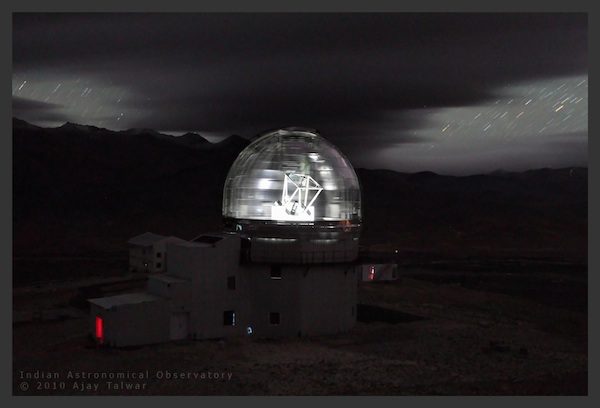
Indian Astronomical Observatory Mount Saraswati, Hanle, Ladakh
Further north from Hanle, on the banks of Pangong Lake at Merak, several telescopes have been installed since a couple of years for checking the suitability of the site for a solar telescope. A number of instruments kept out in the open, a bunker too, on a small piece of sandy land, which is jutting in the lake, like a peninsula. I was fortunate to visit the place in June 2012, just after the Transit of Venus observation from IAO Hanle. The world largest solar telescope has recently been announced by the Indian Institute of Astrophysics. It will be a two metre telescope, which will be able to work in day as well as night. It will be constructed at Merak, right on the bank of Pangong Tso.

Site for National Large Solar Telescope Pangong Tso, Merak, Ladakh
When I want to have an observation site with 360° views of the horizon I head for Hatu peak. The peak is eight kilometres uphill from the town of Narkanda in Shimla District, Himachal Pradesh. This is rare accessible peak where it seems you can see below the horizon in ALL directions. There is no observatory here, just a temple at the end of the road. I have camped here many a times for several nights with my family and all the paraphernalia of astrophotography, including a petrol generator. In the daytime many curious tourists would come and ask questions about you camping here. The peak is at an altitude of 3400 metres, humid at times. The success rate here of getting a clear sky here is about 50%. For me the Hatu peak is a leisurely astronomy destination.
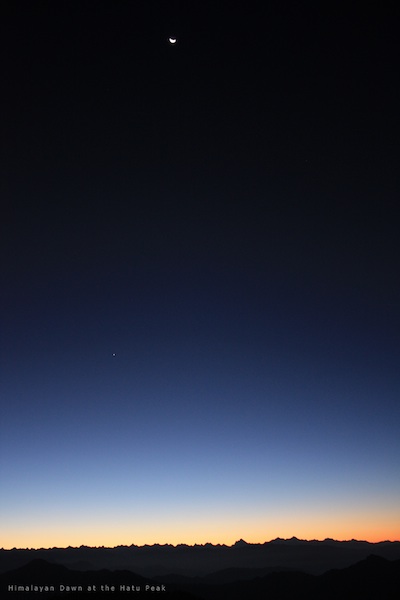
Hatu Peak, Shimla District, Himachal Pradesh
Two other sites that I visit in the Uttarakhand Himalayas are very convenient for astronomy. Although not very high but because there is a resort hotel and a large terrace for setting up my instruments which could work unattended. The first one is the small Himalayan village Majkhali near the famous Ranikhet Cantonment. Here I conduct the “Sky Photo Trip” – Astrophotography workshop. The second one is Binsar, inside the bird sanctuary (National Park) near Almora. Both these places have fantastic views of the Nanda Devi and Trisul Himalayan peaks.
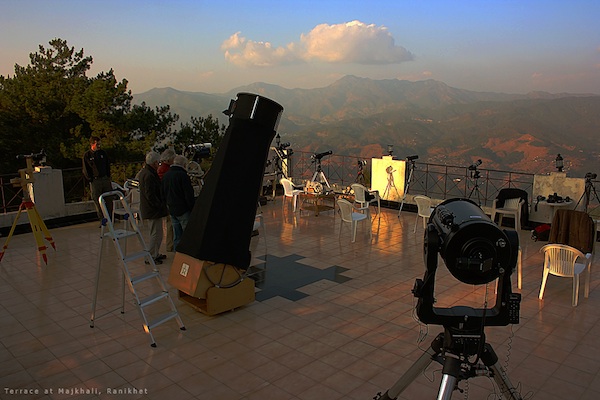
Terrace at Majkhali Ranikhet, State of Uttarakhand
Observing from these fantastic sites in the Himalayas becomes addictive and you never want to observe from below-all-of-the-atmosphere in the plains again!
###
 Ajay Talwar, TWAN photographer from India keeps touring these and many other sites in the Himalayas with his mobile astrophotography paraphernalia. “I find observatories in India very receptive to amateur astronomers, extending all facilities to them at the observatory campuses. The amateur astronomers are in awe of the professionals, but at the same time the professional astronomers are in awe of the amateurs”. Ajay also likes to shoot monuments of Delhi against astronomical subjects to show them in a different light. The Sky Photo Trip – astrophotography workshop in the Himalayas, conducted by Ajay, is a regular feature on the Indian astronomical calendar.
Ajay Talwar, TWAN photographer from India keeps touring these and many other sites in the Himalayas with his mobile astrophotography paraphernalia. “I find observatories in India very receptive to amateur astronomers, extending all facilities to them at the observatory campuses. The amateur astronomers are in awe of the professionals, but at the same time the professional astronomers are in awe of the amateurs”. Ajay also likes to shoot monuments of Delhi against astronomical subjects to show them in a different light. The Sky Photo Trip – astrophotography workshop in the Himalayas, conducted by Ajay, is a regular feature on the Indian astronomical calendar.








I saw your website and was very impressed. I am a practicing Mechanical Engineer -IIT-BHU (Banaras Hindu University)-1991 batch.
but I have also been very interested in astronomy since my school days .
I am originally from Uttarakhand . Can you tell me where exactly is the terraced property you have referred in your website is located in Majkhali -Ranikhet?. I mean the name of the resort , house?. I am planning to build my holiday home/house in Ranikhet and want to plan it from view point of astronomical observations of night sky using telescopes since i wish to pursue again my school days hobby of astronomy full time after i stop working/retire. I will have a look at this place when i visit ranikhet to get an better idea. Any other tips from your side on which aspects to check while selecting plot and building house from view point of astronomical observations of night sky will be very useful.
Will greatly appreciate your help with the above information and suggestions.
Thanks in advance ,
Amit Pant